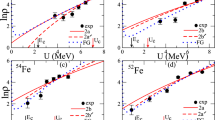Abstract
A model Hamiltonian describing a two-level system with a crossing plus a pairing force is investigated using the technique of large-amplitude collective motion. The collective path, which is determined by the decoupling conditions, is found to be almost identical to the one in the Born-Oppenheimer approximation for the case of a strong pairing force. For the weak pairing case, the obtained path describes a diabatic dynamics of the system.
Similar content being viewed by others
References
A. Klein, N.R. Walet, and G. Do Dang: Ann. Phys.208 (1991) 90.
T. Fukui, M. Matsuo, and K. Matsuyanagi: Prog. Theor. Phys.85 (1991) 281.
J.-P. Blaizot and G. Ripka:Quantum Theory of Finite Systems, The MIT Press, Cambridge (Massachusetts), 1986, p.298.
T. Nakatsukasa and N.R. Walet: Phys. Rev. C57 (1998) 1192.
Author information
Authors and Affiliations
Additional information
This work is supported by EPSRC (UK).
Rights and permissions
About this article
Cite this article
Nakatsukasa, T., Walet, N.R. Large amplitude collective motion in nuclei and metallic clusters — Applicability of adiabatic theory for a pairing model. Czech J Phys 48, 813–816 (1998). https://doi.org/10.1023/A:1021443217783
Received:
Issue Date:
DOI: https://doi.org/10.1023/A:1021443217783



